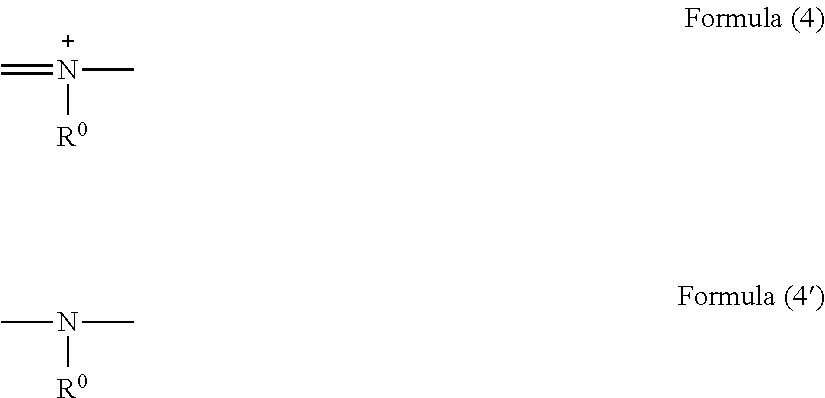Resist underlayer film forming composition containing silicone having onium group
- Summary
- Abstract
- Description
- Claims
- Application Information
AI Technical Summary
Benefits of technology
Problems solved by technology
Method used
Image
Examples
synthesis example 1
Imidazolium Acetate-Containing Siloxane Polymer
[0211]5.0 g of triethoxysilylpropyl-4,5-dihydroimidazole and 18 g of ethanol were charged into a 100 mL flask to be dissolved. While stirring the resultant mixed solution with a magnetic stirrer, to the mixed solution, a solution in which 1.2 g of acetic acid was dissolved in 24 g of ethanol was gradually added at room temperature in a nitrogen atmosphere. The reaction mixture was stirred for half a day and therefrom, ethanol was distilled off under reduced pressure. The resultant concentrate was dropped into 100 mL of diethyl ether and therefrom, triethoxysilylpropyl-4,5-dihydroimidazole and acetic acid as by-products were removed. This purification was repeated three times and then remaining diethyl ether was distilled off under reduced pressure, followed by dissolving the resultant concentrate in ethanol to obtain a 30.4% ethanol solution of triethoxysilylpropyl-4,5-dihydroimidazolium acetate.
[0212]2.94 g of phenyltrimethoxysilane, 3...
synthesis example 2
Ammonium Acetate-Containing Siloxane Polymer
[0213]5.0 g of trimethoxysilylpropyldimethylamine and 24 g of ethanol were charged into a 100 mL flask to be dissolved. While stirring the resultant mixed solution with a magnetic stirrer, to the mixed solution, a solution in which 1.5 g of acetic acid was dissolved in 24 g of ethanol was gradually added at room temperature in a nitrogen atmosphere. The reaction mixture was stirred for half a day and therefrom, ethanol was distilled off under reduced pressure. The resultant concentrate was dropped into 100 mL of diethyl ether and therefrom, trimethoxysilylpropyldimethylamine and acetic acid as by-products were removed. This purification was repeated three times and then remaining diethyl ether was distilled off under reduced pressure, followed by dissolving the resultant concentrate in ethanol to obtain a 13.1% ethanol solution of trimethoxysilylpropyldimethylammonium acetate.
[0214]2.83 g of phenyltrimethoxysilane, 38.00 g of tetraethoxysi...
synthesis example 3
Imidazolium Maleate-Containing Siloxane Polymer
[0215]5.0 g of triethoxysilylpropyl-4,5-dihydroimidazole and 18 g of ethanol were charged into a 100 mL flask to be dissolved. While stirring the resultant mixed solution with a magnetic stirrer, to the mixed solution, a solution in which 2.3 g of maleic acid was dissolved in 18 g of ethanol was gradually added at room temperature in a nitrogen atmosphere. The reaction mixture was stirred for half a day and therefrom, ethanol was distilled off under reduced pressure. The resultant concentrate was dropped into 100 mL of diethyl ether and therefrom, triethoxysilylpropyl-4,5-dihydroimidazole and maleic acid as by-products were removed. This purification was repeated three times and then remaining diethyl ether was distilled off under reduced pressure, followed by dissolving the resultant concentrate in ethanol to obtain a 39.4% ethanol solution of triethoxysilylpropyl-4,5-dihydroimidazolium maleate.
[0216]2.87 g of phenyltrimethoxysilane, 3...
PUM
| Property | Measurement | Unit |
|---|---|---|
| Percent by mole | aaaaa | aaaaa |
| Percent by mole | aaaaa | aaaaa |
| Composition | aaaaa | aaaaa |
Abstract
Description
Claims
Application Information
 Login to View More
Login to View More - R&D
- Intellectual Property
- Life Sciences
- Materials
- Tech Scout
- Unparalleled Data Quality
- Higher Quality Content
- 60% Fewer Hallucinations
Browse by: Latest US Patents, China's latest patents, Technical Efficacy Thesaurus, Application Domain, Technology Topic, Popular Technical Reports.
© 2025 PatSnap. All rights reserved.Legal|Privacy policy|Modern Slavery Act Transparency Statement|Sitemap|About US| Contact US: help@patsnap.com



